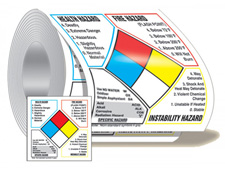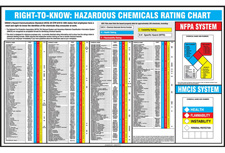| The Home page of ILPI's Safety Data Sheet (SDS) Resource, the leader in SDS information since 1995! | |
| The history and philosophy behind this resource. | |
| A curated collection of books and reference materials concerning Safety Data Sheets and closely related topics. | |
| Paste your plain text SDS into the SDS-Demystifier, and it will be converted into a hypertext-enriched document with links to detailed explanations of each key term. | |
| An extensive list of frequently asked questions about Safety Data Sheets including regulations, content, compliance, and more. | |
| A humorous take on Safety Data Sheet jargon. Fill in the blanks on our entry form to generate a personalized Unsafety Data Sheet to share with your coworkers. | |
| Since 1995, we've maintained this massive curated list of the best places to find Safety Data Sheets on the Internet. | |
| Way more than a glossary, this hypertext-enhanced resource covers hundreds of SDS-related terms and expert knowledge. Each entry includes both the SDS relevance and links to additional authoritative resources. | |
| Archived results of Safety Data Sheet related polls taken by some of our millions of site visitors | |
| You are here! The OSHA regulations behind SDS regulations, including the inspection guidelines and over 400 official interpretations letters under the Hazard Communication Standard | |
| Commercial suppliers of SDS authoring and management software as well as cloud compliance services. | |
| Commercial companies that will create SDS's for your specific needs as well as SDS translation companies. |

Safety signs, banners, and scoreboards? Get yours at Safety Emporium!
| Title: 12/22/1992 - Requirements of hazard communication standard for listing chemicals. | |
| Record Type: Interpretation | Standard Number: 1910.1200(e)(1)(i) |
OSHA requirements are set by statute, standards and regulations. Our interpretation letters explain these requirements and how they apply to particular circumstances, but they cannot create additional employer obligations. This letter constitutes OSHA's interpretation of the requirements discussed. Note that our enforcement guidance may be affected by changes to OSHA rules. Also, from time to time we update our guidance in response to new information. To keep apprised of such developments, you can consult OSHA's website at https://www.osha.gov
December 22, 1992
Dr. Rupert Quentin Bliss
2700 Riverside Avenue
Jacksonville, Florida 32205
Dear Dr. Bliss:
This is in response to your inquiry of October 7, concerning the Occupational Safety and Health Administration's (OSHA) Hazard Communication Standard (HCS), 29 CFR 1910.1200.

Safety Emporium carries NFPA signs and labels like these ones. Plus a whole lot more!
You requested assistance in preparing an inventory of the chemicals in your office and the hazard class for each of the chemicals in a compound. First, we will clarify your responsibility in making an inventory of chemicals in the work place: employers must list the names of all hazardous chemicals used in the workplace by using the identity that is referenced on the material safety data sheet (MSDS). This identity is often a common name, such as the product or trade name (i.e. Lime-A-Way). The rule does not require that you indicate the hazards of each chemical on the list; employees are informed of hazards through MSDSs and labels.
Since this may be a point of confusion for you, we will briefly explain the HCS's hazard determination requirements. Chemical manufacturers must either determine the hazards of the product as a whole or assume that the mixture presents the same health hazards as its components. In cases where a chemical mixture or compound has not been tested as a whole, the manufacturer's MSDS must list all of chemical components that have been determined to be hazardous which comprise one percent or greater of the mixture, or 0.1 percent or greater for components that are considered carcinogenic. In either case, where the hazard has been determined for the mixture or the individual components of the mixture, all of the information should be provided for the employer and employees in the MSDS.
If you feel that the MSDS provided to you does not adequately notify you of all hazards, you may contact the chemical manufacturer for more information or refer the inadequacy to your OSHA area office:
U.S. Department Of Labor - OSHA
3100 University Blvd. South
Room 303
Jacksonville, Florida 32216
Phone: (904) 791-2895
We hope this information is helpful. If you have any further questions please feel free to contact us at (202) 219-8036.
Sincerely,
Ruth Mccully,
Director
Office of Health Compliance Assistance
October 7, 1992
OSHA
U.S. Department of Labor
200 Constitution Avenue N.W.
Washington D.C. 20210
RE: Hazardous Class Information
Dear Sirs:

This poster from Safety Emporium contains NFPA numeric ratings for hundreds of common chemicals.
Attached please find a list of all the chemicals found in compounds typically used in a dental office and often found in my dental office. All of the potentially hazardous or dangerous compounds now have MSDS's supplied with them as required by rule. Often times the hazardous class information supplied by the MSDS relates to the compound as a whole unit rather than the individual chemicals in the compound.
In order to have an accurate listing of chemicals and their hazard class I need a reference to look up each of the chemicals in a compound.
I currently have a basic Hazardous Class Listing of the more common chemicals but many of the newer dental products have a complex mixing of chemicals some of which I can not find specific hazard classification on the supplied MSDS.
I would appreciate any help you can give me in this matter.
Sincerely,
Rupert Quentin Bliss, D.D.S.
RUPERT QUENTIN BLISS, D.D.S
2700 RIVERSIDE AVENUE
JACKSONVILLE, FLORIDA 32205 (904) 387-0469
ATTACHMENT:
Listing of potentially hazardous chemicals 10 pages
The original official public domain version of this document is available from OSHA at https://www.osha.gov/laws-regs/standardinterpretations/1992-12-22.